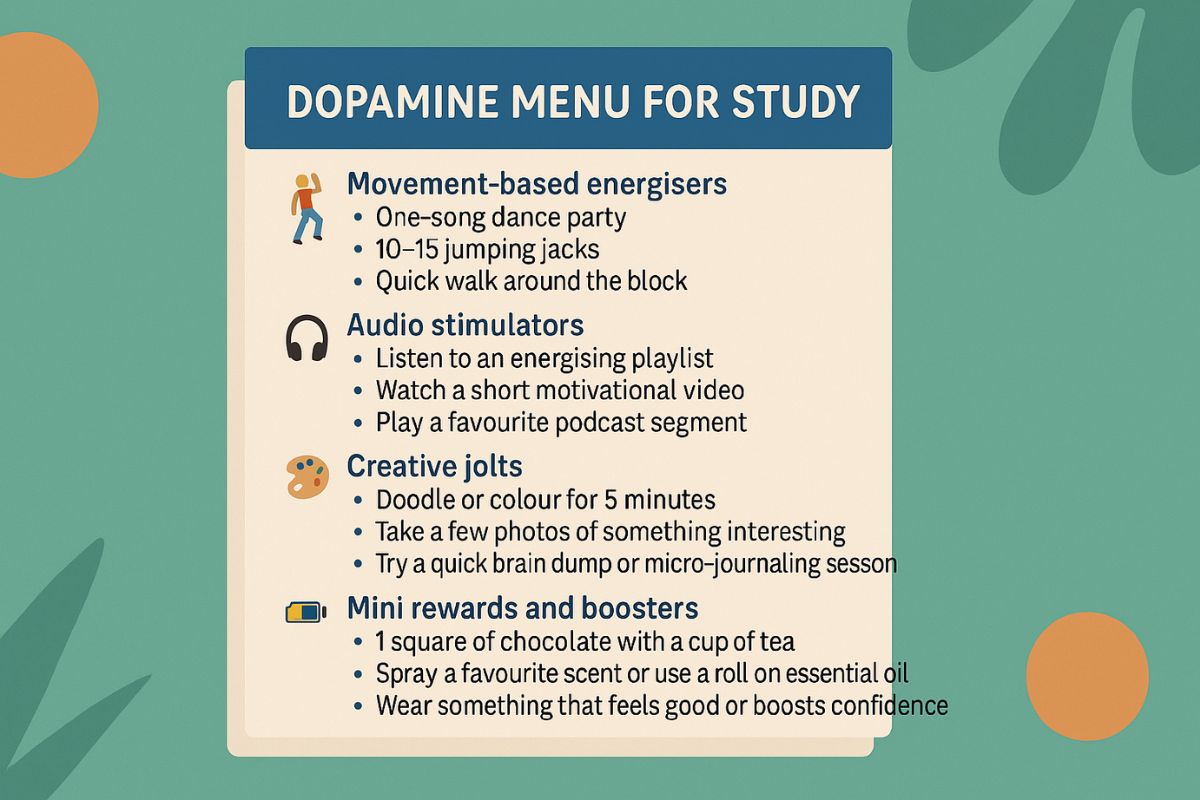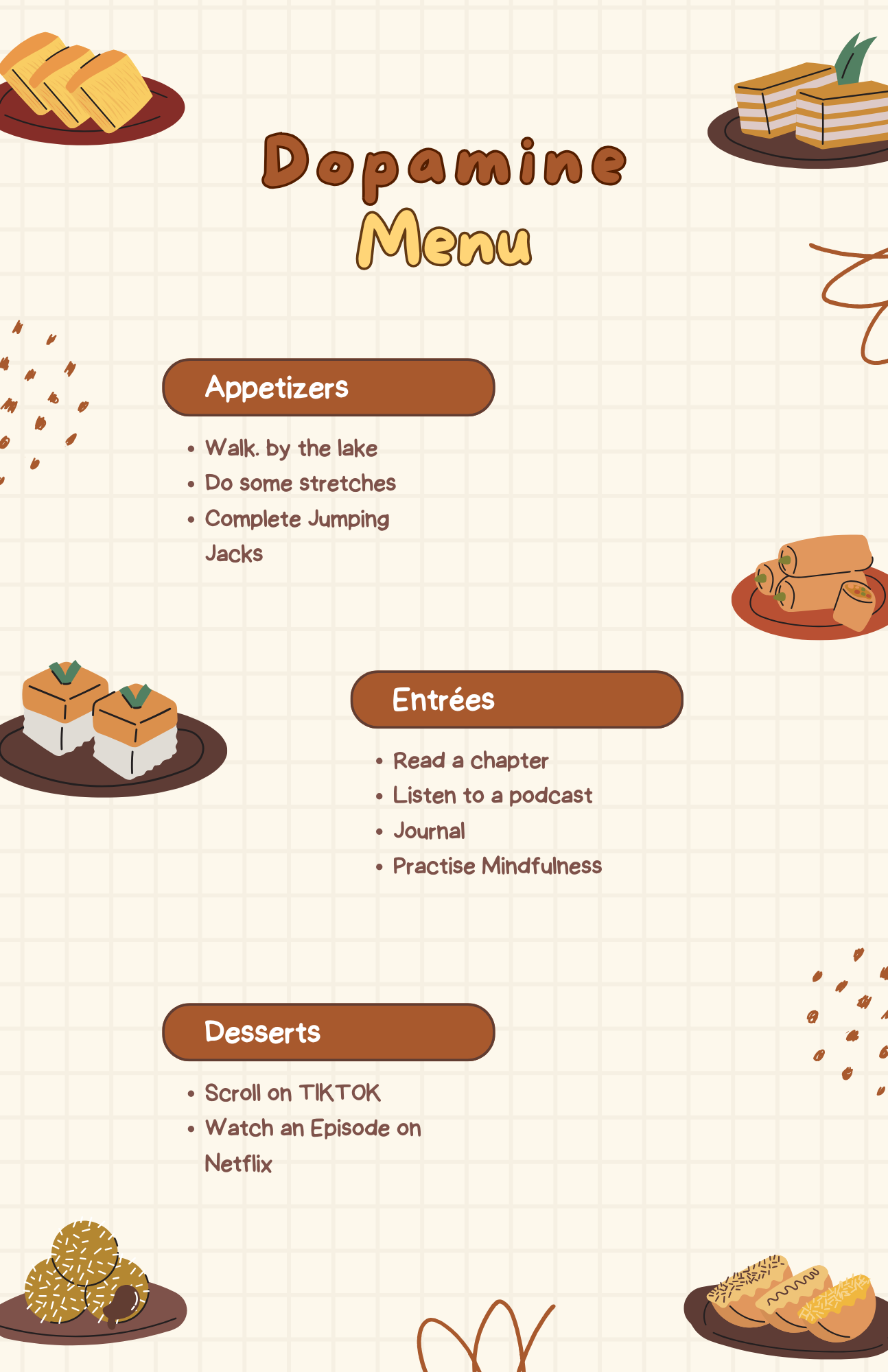
A dopamine menu is a fun, energising way to get yourself study-ready by using pre-planned activities that boost mood, focus, and motivation—especially when calm isn’t cutting it.
A few years back, while running Studyology – our procrastination workshop series – I found myself talking with students about the idea of a study entry ritual: something you do before sitting down to study that signals to your body and brain it’s time to switch gears.
I framed it then as a way to calm the nervous system. For many students, opening the laptop or textbook is a moment filled with overwhelm – not boredom. So something relaxing made sense. Think mindfulness meditation, breathing exercises, stretching, or a cup of tea.
But one student challenged that framing.
They explained that for them, the issue wasn’t overactivation – it was underactivation. Their ritual needed to rev them up, not calm them down. They needed energy, stimulation, movement.
That comment stayed with me.
Fast Forward: Discovering the “Dopamine Menu”
Recently, one of our Student Success and Wellbeing Advisors shared something a student had introduced them to: the idea of a Dopamine Menu. It turns out it’s a fairly common idea among people with ADHD, who often need to actively seek out healthy sources of stimulation to feel motivated and focused. The student even shared their own menu.

The concept was new to me, but I found a great explainer on ADDitude Magazine. A Google search will also find you a bunch of articles on the topic.
The core idea?
Have a menu of healthy, stimulating activities that you can use to boost your mood, energy, and focus.
People often turn to not-so-healthy options when they feel flat: endless scrolling, junk food, or doing anything other than the task they’re avoiding. A dopamine menu is a way to be more intentional about what you do to lift yourself up.
Why It Might Help Before Studying
Study aside, the idea of reflecting and developing a list of mood and focus enhancing activities makes a lot of sense. It reminds me of another tool we recommend — the Coping Plan — where you map out helpful actions for when you’re feeling overwhelmed or low. The Dopamine Menu shares that same spirit of planning ahead, but with a twist: it focuses on energising, uplifting, and activating you when you’re flat or disengaged. Less ‘how do I get through this tough moment?’ and more ‘how do I get moving and find my flow?’
But, being a mental health person in a university, I can’t help but think how it could be related to study.
Generally speaking, we learn better and feel more motivated when we’re in a positive mood state. Trying to study while flat, foggy, or frustrated is hard (although don’t use those mood states as reasons to not study!)
So the idea of using a dopamine-boosting activity to see if we can get ourselves into a study-ready state makes a lot of sense.
It’s also a great alternative to calming rituals, especially for students who find that relaxing before study just leads to… more relaxing. Feel stressed? Do a calming ritual. Feel flat? Do a boosting activity.
Examples: Building Your Own Study-Prep Dopamine Menu
I asked AI to help me come up with some example items students might include in their dopamine menu, specifically as pre-study rituals:
🕺 Movement-based energisers
-
One-song dance party
-
10–15 jumping jacks
-
Quick walk around the block
-
Short yoga flow with upbeat music
🎧 Audio stimulators
-
Listen to an energising playlist (I often put on Meshuggah if I need to work through emails)
-
Watch a short motivational video
-
Play a favourite podcast segment
🎨 Creative jolts
-
Doodle or colour for 5 minutes
-
Take a few photos of something interesting
-
Try a quick brain dump or micro-journaling session
🔋 Mini rewards and boosters
-
1 square of chocolate with a cup of tea
-
Spray a favourite scent or use a roll-on essential oil
-
Wear something that feels good or boosts confidence
🌞 Sensory wake-ups
-
Splash cold water on your face
-
Open the window or step outside
-
Do a quick tidy of your desk to reset your space
What Works for Me
For me, the sweet spot is somewhere in the middle. I’ve found that gentle activity early in the day – like a walk with a friend or podcast – generally puts my nervous system in a good place. Not too wired, not too sluggish. Consistent with this, catching public transport to work seems to work for me because the light movement and change of scenery seem to warm up my system without overwhelming it.
If I just try to drag myself from bed straight into work, it never really clicks (also my colleagues complain that I am still in my pyjamas).
Create Your Own Menu
If this idea resonates, consider taking five minutes to jot down your own dopamine menu. You might even split it into:
-
Quick Hits (1–2 minutes)
-
Short Boosts (5–10 minutes)
-
Reset Rituals (10+ minutes)
Then, when you find yourself staring at the screen and feeling not ready, try something from your menu first. It might just be the difference between staying stuck and finding your flow.

